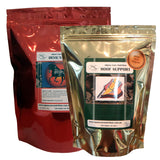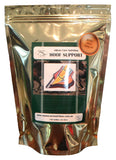Laminitis in autumn
 We tend to associate Spring with being the worse time for laminitis, but for some horses Autumn can be the more troubling period. This has less to do with sugars in pasture, and more to do with fluctuating hormonal levels in the body.
We tend to associate Spring with being the worse time for laminitis, but for some horses Autumn can be the more troubling period. This has less to do with sugars in pasture, and more to do with fluctuating hormonal levels in the body.
Late Summer and Early Autumn sees a rise in the pituitary hormone ACTH. This is a natural fluctuation and for most horses it does not cause any problems, and as horse owners we are completely unaware. However, if a horse or pony has insulin resistance or early stage Cushing’s disease then this seasonal fluctuation can lead to laminitis.
In an insulin resistant animal, insulin sensitive cells do not respond normally to the hormone insulin. Insulin’s job is to get glucose from the bloodstream into body cells, if insulin sensitive cells do not respond properly it takes more insulin to get this job done. Unfortunately, high levels of insulin can cause laminitis. In the Autumn, the rise in ACTH levels causes more cortisol to be released from the adrenal gland. Excessive cortisol worsens insulin resistance and for the insulin resistant horse or pony this can be enough to trigger a laminitic episode.
Early signs of insulin resistance to be on the look-out for include weight gain without any dietary change, fat deposits along the neck, shoulders and tail base, depression, increased water consumption and urination. Also be on the look-out for signs of foot pain: tenderness on hard ground, shortened stride, stiff movements, reluctance to turn, reluctance to move when asked, reduced activity. These may be present before any significant heat is felt in the foot or the horse adopts the weight shifted laminitic stance.
If you do suspect a rise in ACTH is causing problems for your horse or pony then talk to your vet about checking ACTH levels. They may also decide to prescribe pergolide to help control ACTH levels. Dietary control is also very important with a low sugar, hay based diet and balanced minerals.
The development of laminitis in the Autumn can also be a sign of early stage Cushing’s disease (Pituitary pars intermedia dysfunction). Cushing’s/PPID is caused by a tumour on the pituitary gland which results in a greater production of ACTH. A horse with ‘full blown’ Cushing’s has ACTH levels that are elevated all year round, but a horse does not get to this stage overnight. It can sometimes be several years before the condition has led to year round elevated ACTH levels and the recognisable non-shedding, curly coat stage. As well as the occurrence of laminitis in the Autumn, be on the look-out for weight loss, loss of topline, pot belly, increased appetite, increased water consumption and urination, skin sensitivities, minor shedding changes, worsening insulin resistance, changes in behaviour/attitude or activity levels.
If your horse has had an episode of unexplained Autumn laminitis in the past talk to your vet about testing for ACTH levels, similarly, any insulin resistance horse in their teens or older, any horse in their teens with a collection of early PPID symptoms starting late Summer/early Autumn, and even if you have a known PPID horse, talk to your vet to ensure that their treatment is adequate to manage the rise in ACTH at this time of year.
|
RELATED PRODUCTS |
|||
 |
 |
 |
 |
| Laminitis Recovery |
Hoof Support |
Devil's Claw |
Omega-3 |